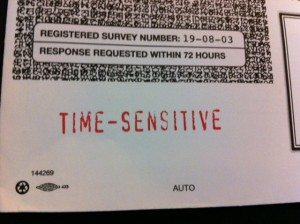The Activist Attitude: 5 Ways to Fundraise like an Activist
/Earlier this week, I talked about cultivating an Activist Attitude. Now we're going to get down to the nitty-gritty: what can you do in your fundraising to frame your organization in a more activist, we're-changing-the-world way?
Now we're going to get down to the nitty-gritty: what can you do in your fundraising to frame your organization in a more activist, we're-changing-the-world way?
Here are 5 ways to fundraise like an activist:
1. Include an Involvement Device.
For more traditionally activist organizations, this is often a petition to a person in authority. They work. Not only do they inspire people to respond to your direct mail or your email solicitation, but they also show you who your most passionate and engaged supporters are.
But you don't have to do a petition to involve your donors! Try a survey. Ask donors what they think about various aspects of your work or the issue you're focused on. One client had such good results with the survey they used in Acquisition, that they included one in a renewal effort, as well.
Another great involvement device that doesn't get used often enough is asking your donors to sign a Declaration of Support. This gets donors signing on to your mission, making them a key player in your work. And you can use these signed declarations in a variety of ways, from delivering them to a decision-maker or displaying them prominently in your headquarters as a Wall of Support.
2. Have an Urgent Call to Action.
 You know urgency is key to fundraising, so pair it with a call to action. For many activist organizations, this is tied to a specific campaign, but if you've got your Activist Attitude turned on, you'll see many ways to use it.
You know urgency is key to fundraising, so pair it with a call to action. For many activist organizations, this is tied to a specific campaign, but if you've got your Activist Attitude turned on, you'll see many ways to use it.
Your donors have full lives, so you need to give them a reason not to set that fundraising piece down on the “I’ll get to this later” pile.
Make your asks urgent. Tell your donors you need their help NOW. Better yet, give them a deadline by which to act. And make it sooner rather than later. Plaster that deadline on the outer envelope, on the reply form, in the letter and on the reply envelope. Explain to them why it’s so important that they act fast.
And give them specifics about what you're asking them to do. Tell them how much you want them to give or what you want them to sign and what that action will do.
Instead of "You can feed the hungry this winter", think: "Respond within 14 days to feed hungry families this month!" Or "Your gift of $XX will feed YY hungry families -- give now!"
3. Find an Enemy.
Your enemy doesn't have to be a political leader, as it is for many activist organizations. An enemy can be abstract, like the weather. Or it can be systemic, a bureaucracy that your organization helps people navigate. Enemies are fundraising gold. Is someone trying to stop you from accomplishing what you need to accomplish? Is there a system standing between you and success?
People love rooting for the little guy. When you have powerful forces arrayed against you, your donors will want to help you.
Need a softer "enemy"? Think roadblocks or obstacles instead. Staff stretched too thin? Funding troubles? Lack of awareness about your organization or a particular program?
All of these roadblocks can be cast as enemies, forcing your audience to wonder how you can possibly overcome. (And of course, you’ll tell them that THEY are the key to solving any problem that comes your way!)
4. Empower Your Donors.
You already know you need to be donor-centric, right? Well, a really great way to be donor-centric is to tell them this truth: they are changing the world. Every time a donor makes a gift, volunteers, or takes an action on your behalf, they are saying, "Yes, I want to help your organization solve this problem!"
Activist organizations understand this inherently, and they let their donors know that their enthusiastic embrace of their missions makes a difference. They give them many opportunities to participate -- from telephone town halls, to news updates via email and in the mail, to gatherings with organizational leadership, and social media engagement.
Your donors are your tribe, the heroes who make your work possible. Your donors wield a great deal of power to re-shape the world in the way you're working to reshape it. Engage them in conversation, listen to their voices, and give them as many opportunities as you can to use their power!
5. Embrace Your Righteousness.
You believe your cause is important, right? You are passionate about the work you do and believe that it is critical to creating a better world for us all. Embrace that.
Successful activist organizations stick to their messages because they know without a doubt that they are right. They own it, and they don't back down -- they fight hard and don't compromise their beliefs. And that righteousness breeds trust in those who share their vision.
Don't be afraid to stand up for your mission. And don't apologize for your passions. Yes, there may very well be causes that are more life-and-death than yours. But your donors are looking to you for leadership on your issue. And your work is right.
Above all, embrace your Activist Attitude!
With a little more activism injected into your fundraising, you just might see more energy among your staff, your supporters and your fundraising.























